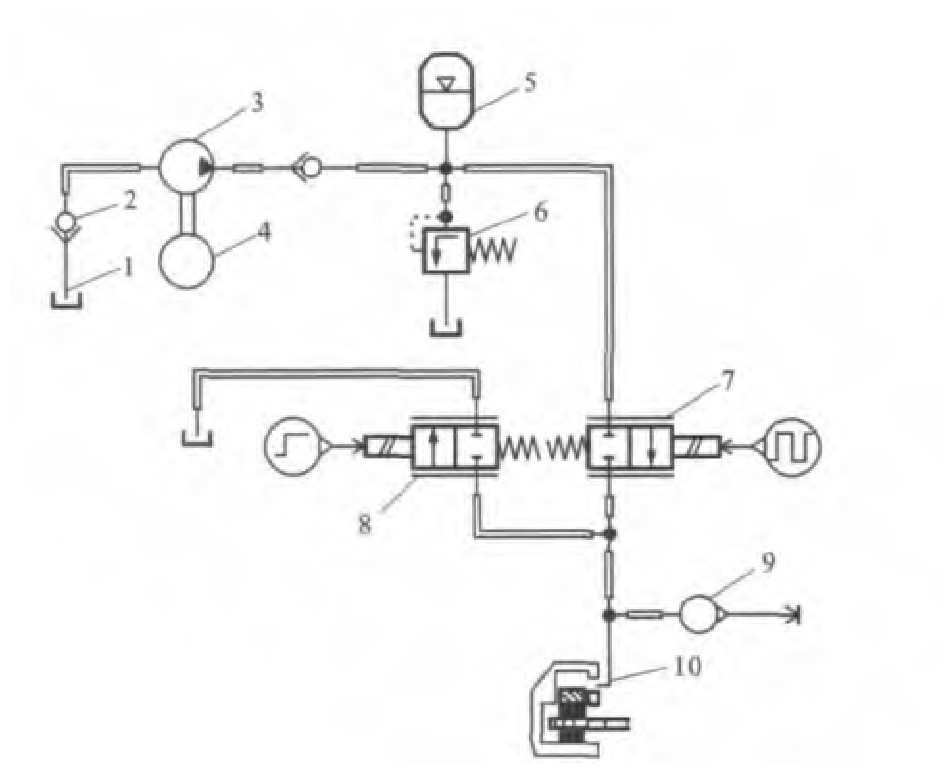Variation characteristic of wheel cylinder pressure in electro-hydraulic braking system controlled by PWM signal
-
摘要: 为了降低线控液压制动系统轮缸压力波动,采用稳态压力变化值表征轮缸压力变化率,研究了轮缸压力变化率在轮缸工作压力范围内的变化规律,推导了轮缸稳态压力变化值的计算公式,采用试验方法测得了系统稳态压力变化值随占空比与初始压力变化的脉谱图。计算结果表明:在升压过程中,轮缸压力变化率与初始压力的关系存在拐点,在拐点右侧,压力变化率随压力升高而降低,而在拐点左侧,压力变化率随压力升高而升高。不同占空比下轮缸压力变化率曲线的拐点对应的轮缸压力大体相同,此压力是活塞终止行程压力,在本系统中,此压力约为2.9 MPa。在压力变化的全部范围内,压力变化率与占空比之间的关系近似呈线性。Abstract: In order to decrease the variation amplitude of wheel cylinder pressure for electro-hydraulic braking system(EHB), the pressure variation rate was represented by the stable pressure variation value, and the variation law in the working range was investigated. The formula to calculate the stable pressure variation value was deduced, some experiments were carried out to measure the stable pressure variation values under different initial pressures and duty cycles. Calculation result shows that the curves of the rates have inflection points according to the initial pressures. At the left side of every inflection point, the pressure variation rate increases with the increase of initial pressure. While at the right side, the rate decreases. The inflection points at different duty cycles appear at the nearly same cylinder pressure. As the inflection point is caused by piston motivation, it is named as piston motivation's end pressure. In the system, it is about 2.9 MPa. The relationship between the pressure rate and the duty cycle is approximate linear in working pressure range.
-
表 1 最大稳态压力变化值
Table 1. Maximal stable pressure variation values

表 2 稳态压力变化值
Table 2. Stable pressure variation values

-
[1] SCHENK D E, WELLS R L, MILLER J E. Intelligent braking for current and future vehicles[C]//SAE. SAE International Congress and Exposition1995. Detroit: SAE, 1995: 43-46. [2] NISHIMAKI T, YUHARA N, SHIBAHATA Y, et al. Two-degree-of-freedom hydraulic pressure controller design for direct yaw moment control system[J]. JSAE Review, 1999, 20(4): 517-522. doi: 10.1016/S0389-4304(99)00041-7 [3] YOU S H, HAHN J O, CHO Y M, et al. Modeling and control of a hydraulic unit for direct yaw moment control in an automobile[J]. Control Engineering Practice, 2006, 14(9): 1011-1022. doi: 10.1016/j.conengprac.2005.06.002 [4] JONNER W D, WINNER H, DREILICH L, et al. Electro hydraulic brake system—the first approach to brake-by-wire technology[C]//SAE. SAE International Congress and Exposition1996. Detroit: SAE, 1996: 105-112. [5] AHN J K, JUNG K H, KIM D H, et al. Analysis of a regenerative braking system for hybrid electric vehicles using an electro-mechanical brake[J]. International Journal of Auto-motive Technology, 2009, 10(2): 229-234. doi: 10.1007/s12239-009-0027-z [6] PETRUCCELLI L, VELARDOCCHIA M, SORNIOTTI A. Electro-hydraulic braking system modelling and simulation[C]//SAE. SAE21st Annual Brake Colloquium and Exhibition. Hollywood: SAE, 2003: 1-8. [7] HONG D, HWANG I, YOON P, et al. Development of a vehicle stability control system using brake-by-wire actuators[J]. Journal of Dynamic Systems, Measurement, and Control, 2008, 130(1): 1-9. [8] 祁雪乐. ABS液压制动系统动态特性研究和综合仿真匹配平台的建立[D]. 北京: 清华大学, 2005.QI Xue-le. Research on dynamic response of ABS hydraulic brake system and development of integrated platform for simulating matching[D]. Beijing: Tsinghua University, 2005. (in Chinese). [9] 沙宏亮. 基于轮缸压力估算的轻型车ESP控制算法研究[D]. 长春: 吉林大学, 2008.SHA Hong-liang. Research on ESP's control algorithm for light vehicle based on the estimation of wheel cylinder pressure[D]. Changchun: Jilin University, 2008. (in Chinese). [10] 于良耀, 王会义, 宋健, 等. 汽车防抱制动系统中液压系统性能评价与试验[J]. 机械工程学报, 2007, 43(9): 40-46. https://www.cnki.com.cn/Article/CJFDTOTAL-JXXB200709011.htmYU Liang-yao, WANG Hui-yi, SONG Jian, et al. Performance evaluation and test of anti-lock braking system hydraulic system[J]. Chinese Journal of Mechanical Engineering, 2007, 43(9): 40-46. (in Chinese). https://www.cnki.com.cn/Article/CJFDTOTAL-JXXB200709011.htm [11] JEONG H S, KIM H E. Experimental based analysis of the pressure control characteristics of an oil hydraulic three-way on/off solenoid valve controlled by PWM signal[J]. Journal of Dynamic Systems, Measurement, and Control, 2002, 124(1): 196-205. doi: 10.1115/1.1433483 [12] 李志远, 刘昭度, 崔海峰, 等. 汽车ABS制动轮缸压力变化速率模型试验[J]. 农业机械学报, 2007, 38(9): 6-9. https://www.cnki.com.cn/Article/CJFDTOTAL-NYJX200709004.htmLI Zhi-yuan, LIU Zhao-du, CUI Hai-feng, et al. Experimental study on change rate model of brake pressure of ABS wheel cylinder[J]. Transactions of the Chinese Society for Agricultural Machinery, 2007, 38(9): 6-9. (in Chinese). https://www.cnki.com.cn/Article/CJFDTOTAL-NYJX200709004.htm [13] 郭孔辉, 刘溧, 丁海涛, 等. 汽车防抱制动系统的液压特性[J]. 吉林工业大学自然科学学报, 1999, 29(4): 1-5. https://www.cnki.com.cn/Article/CJFDTOTAL-JLGY199904000.htmGUO Kong-hui, LIU Li, DING Hai-tao, et al. A study on hydraulic characteristics of anti-lock braking system[J]. Journal of Jilin University of Technology: Natural Sciences, 1999, 29(4): 1-5. (in Chinese). https://www.cnki.com.cn/Article/CJFDTOTAL-JLGY199904000.htm [14] 王吉华, 魏民祥, 杜言利, 等. 基于T-S模糊模型的多轴转向车辆H∞鲁棒控制[J]. 交通运输工程学报, 2012, 12(4): 42-49. http://transport.chd.edu.cn/article/id/201204006WANG Ji-hua, WEI Min-xiang, DU Yan-li, et al. H∞ robust control of multi-steering vehicle based on T-S fuzzy model[J]. Journal of Traffic and Transportation Engineering, 2012, 12(4): 42-49. (in Chinese). http://transport.chd.edu.cn/article/id/201204006 -





 下载:
下载:












